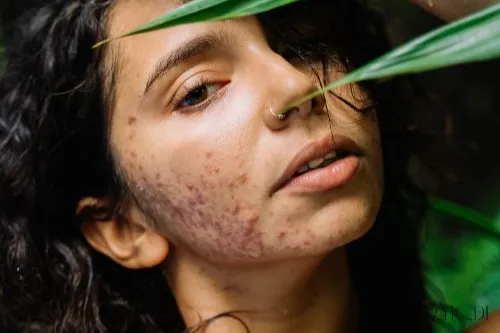As a board-certified dermatologist, one of the most frequent topics my patients bring up is the connection between diet and acne. There's so much conflicting information online, passed down through families, or shared among friends – it's completely understandable why people are confused and often frustrated. While what we eat can influence our skin, many widely held beliefs about food and acne are based more on myth than on solid scientific evidence.
Before we dive in, let's remember the core factors driving acne: hormones (especially androgens stimulating oil production), genetics (predisposing you to acne), clogged pores (from excess oil and dead skin cells), bacteria (Cutibacterium acnes), and inflammation. Diet can potentially influence some of these factors, particularly inflammation and hormonal pathways, but it's rarely the sole cause. Let's clear up 5 common myths I hear all the time:
Myth 1: Eating Greasy Foods (like Pizza and Fries) Causes Acne.
- The Belief: The logic seems simple – greasy food equals greasy skin, which equals breakouts.
- The Reality: This is largely a myth based on a misunderstanding. The oil you eat doesn't directly translate to the oil (sebum) produced by your skin's sebaceous glands. While working in a greasy environment (like a kitchen) where oil splatters onto your face can contribute to clogged pores (a type of acne called acne mechanica), ingesting typical amounts of fats in foods like pizza or fries hasn't been scientifically shown to directly cause acne for most people. A diet consistently high in processed foods and unhealthy fats isn't great for overall health, which can indirectly impact skin, but blaming a single slice of pizza for a breakout is usually unfounded.
Myth 2: Chocolate is a Guaranteed Pimple Trigger.
- The Belief: Chocolate is frequently cited as a major acne culprit.
- The Reality: The evidence linking chocolate itself directly to acne is weak and conflicting. Early studies were often poorly designed. More recent research suggests that it might not be the cocoa itself, but rather the high sugar and dairy content often found in milk chocolate bars that could be a trigger for some susceptible individuals. Dark chocolate, with lower sugar and dairy content and higher antioxidant levels, is less likely to be implicated. If you notice breakouts after eating specific types of chocolate, it might be related to the sugar/dairy content or another ingredient, rather than the cocoa.
Also read: The Power of Three: A Dermatologist-Approved Minimalist Skincare Routine
Myth 3: You MUST Eliminate All Dairy to Clear Your Skin.
- The Belief: Dairy, especially milk, is universally bad for acne-prone skin.
- The Reality: This is an area with some scientific backing, but it's far from universal and requires nuance. Studies have shown an association between dairy intake (particularly skim milk) and increased acne prevalence and severity in some populations. Potential reasons include hormones naturally present in milk or milk's effect on insulin and Insulin-like Growth Factor 1 (IGF-1), which can increase sebum production. However:
- The link is not definitive for everyone.
- Fermented dairy like yogurt or cheese seems less associated with acne.
- Cutting out an entire food group without clear personal evidence can lead to nutritional deficiencies.
- My Advice: If you suspect dairy is a trigger, consider reducing intake or switching from skim to whole milk (as some studies suggest a weaker link here) or trying dairy alternatives for a few weeks and observing your skin objectively. Don't assume it's a trigger without evidence.

Myth 4: Sugar Itself Directly Causes Pimples.
- The Belief: Eating sugary candy or desserts leads directly to breakouts.
- The Reality: While not quite direct causation, there's a stronger link here than with grease or pure chocolate, but it relates to glycemic load. Foods with a high glycemic index (like sugary drinks, white bread, pastries, candy – things that rapidly raise blood sugar) cause a spike in insulin and IGF-1. As mentioned with dairy, elevated IGF-1 can stimulate sebaceous glands to produce more oil and increase inflammation, potentially worsening acne. So, it's less about sugar in isolation and more about the overall effect of high-glycemic-load foods on your hormones and inflammation.
- My Advice: Focusing on a low-glycemic diet rich in whole grains, fruits, vegetables, and lean proteins, while limiting high-glycemic processed foods and sugary drinks, can be beneficial for some individuals with acne and is excellent for overall health anyway.
Myth 5: Drinking Tons of Extra Water Will "Flush Out" Acne.
- The Belief: Dehydration causes acne, so drinking gallons of water will clear it up.
- The Reality: Staying adequately hydrated is crucial for overall health and helps maintain skin hydration and function. Dehydrated skin can sometimes look duller or emphasize fine lines, and barrier function might be slightly impaired. However, acne's core mechanisms involve hormones, sebum, bacteria, and inflammation within the hair follicle. Drinking excessive amounts of water beyond normal hydration needs won't magically flush out clogged pores or stop hormonal influences. Your kidneys regulate your body's water balance efficiently.
- My Advice: Drink enough water throughout the day to stay properly hydrated (clear to pale yellow urine is a good indicator). Don't force yourself to drink excessive amounts expecting it to cure your acne – focus on evidence-based acne treatments instead.
Also read: Unlocking Your Best Skin: A Dermatologist's Guide to Retinols and Prescription Retinoids
The Bottom Line: Focus on Balance and Evidence
While diet isn't typically the primary cause of acne for most people, it can be an influencing factor, particularly diets high in processed, high-glycemic foods or, for some individuals, dairy. Instead of resorting to overly restrictive elimination diets (which can be stressful and nutritionally risky), focus on:
- A Balanced, Whole-Foods Diet: Prioritize fruits, vegetables, lean proteins, healthy fats, and complex carbohydrates. This supports overall health and reduces inflammation.
- Mindful Observation: If you strongly suspect a specific food trigger, eliminate it systematically for several weeks (at least 4-6) and monitor your skin closely. Reintroduce it and see if there's a clear change. Keep a food diary if helpful.
- Consult a Professional: Don't rely solely on dietary changes. Acne is a medical condition. A board-certified dermatologist can provide an accurate diagnosis, rule out other conditions, and recommend effective treatments (topical retinoids, benzoyl peroxide, antibiotics, hormonal therapies like birth control or spironolactone, isotretinoin) tailored to your specific type and severity of acne.
Diet is one piece of a complex puzzle. Let's focus on evidence-based approaches and stop stressing over food myths!

